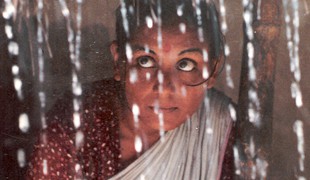En tant que présidente du NETPAC (Network for the Promotion of Asian Cinema), Aruna Vasudev était présente aux côtés de Jahnu Barua pour inaugurer sa rétrospective au Jeu de Paume. Pour compléter son texte de 1995 « Le nouveau cinéma indien » — précédemment publié sur le Magazine, nous lui avons demandé quelles sont aujourd’hui les tendances du cinéma d’auteur en Inde.
Le Magazine: In your article «Le nouveau cinéma indien», you talked about the existence of a schism between commercial / popular cinema and the New Cinema backed by the State. Are there more connections between the two spheres today?
Aruna Vasudev:The distinction between the parallel art cinema and the popular commercial cinema has practically disappeared now. In fact, there is a sort of «art cinema» movement emerging out of the heart of popular cinema. New young filmmakers in Bollywood, like Anurag Kashyap and Dipakar Banerjee, are making films that could be considered as a parallel movement to the hard-core commercial cinema in Hindi today. They are being shown in international film festivals and doing very well. Some of these directors are also producing, or helping to produce, the work of new filmmakers.
Le Magazine: In 1995 you identified the supremacy of the theme (always linked to social issues) over the cinematic style and treatment of New Wave cinema films. Is this radical separation between social realism and creative expression still relevant today? Can we talk about a diversification of topics after 1995?
Aruna Vasudev: The quality of commercial cinema has ameliorated dramatically and the production of films has altered radically. From the staging of the song and dance sequences, to the lighting, costumes, camera and editing, all is very professional now. The main problem remains the scripting and a sort of stereotyped acting by the stars. But young actors are emerging, along with new filmmakers, and are being accepted by audiences. There is still not enough emphasis placed on scripts, but even a Bollywood megastar like Aamir Khan has a very strong current of social issues in all the films which he either produces or acts in. His mega box office hit «Taare Zameen Par» («Stars on Earth», 2007) dealt with dyslexia among children, and a strong story was built around this theme. Rakeysh Omprakash Mehra directed «Rang de Basanti» («Color of Sacrifice», 2006), produced by Aamir Khan, which a very strong political and social criticism background through the story of young students who lose all faith in the political system.
The past three or four years have also seen the emergence of new filmmakers following their own very distinct and original styles as well as themes. I am thinking about Amir Bashir’s «Harud» («Autumn», 2010) – about the tragic situation for the youth in Kashmir -, Sidharth Srinivasan’s «Pairon Talle» («Soul of Sand», 2010) – about honour killings in India, where families oppose love and marriage between young couples of different castes -, or Ajita Suchitra Veera’s «Ballad of Rustom» (2011), which follows its own radical style on the lines of the earlier leading directors of the New Wave in the 70s, Mani Kaul and Kumar Shahani, among a host of others.
New sources of funding have made an appearance, replacing the established producers. The corporate sector has emerged to finance both radical and popular films. The National Film Development Corporation, which was directly responsible for the emergence of a New Wave in Indian cinema in the early 70s, has re-emerged as a strong force today with script development workshops, opening up new possibilities of production and co-production. Now, finally, it is starting a chain of cinemas d’art et d’essai, which is going to transform the Indian cinema scene when it starts operating in another year or so.
Le Magazine: In your article, you talk about the importance of ciné-clubs in the making of potential indian filmakers’ tastes in the sixties and seventies. Considering the fact that, as in France, these institutions are becoming rare, can we say that museums and art institutions are assuming this mission?
Aruna Vasudev: In India, institutions and museums are really not interested in showing other films than documentaries directly related to art. However, film societies are very active in different parts of India.
For instance, in the State of Kerala, in Southern India, there are 96 film societies, with international film festivals in various cities. The bigest festival is the annual Trivandrum International Film Festival of Kerala (IFFK), which recently started an annual documentary festival. In the State of Karnataka there are also 40 film societies, in Maharashtra there are 50 and the number is growing! In Bengal, where the film society movement was very strong when Satyajit Ray and others iniciated it soon after India’s independence in 1947, there are only about 70. All these come under the Indian Federation of Film Societies, and they all show international films.
The number of film festivals is growing every year. The major ones today are the International Film Festival of India in Goa, which is run by the national government. The others are independent and subsided by the State. The major ones today are in Mumbai, Trivandrum, Kolkata (Calcutta), Bangalore, Pune, Chennai. The Cinefan Festival of Asian Cinema in Delhi unfortunately closed down after eleven years, but there are three annual independent documentary film festivals in Delhi, plus the International Film Festival for Children in Hyderabad and the Mumbai International Film Festival of Documentary and Short Films – both of which are held every two years and run by the government.
Many other cities in India are now starting film festivals on a small scale, but it is a movement that is clearly growing. There are emerging young film festivals in Jaipur, Trichur, Gandhinagar, Surat, Jamshedpur and other places. There is, therefore, no shortage of films shown all over the country.
Le Magazine: Which are the current distribution channels for independent cinema in India?
Aruna Vasudev: Art films do not always find distribution in India, but audience taste is changing, and a new young audience is showing interest in this kind of cinema. The real difficulty, which has been there from the beginning of the New Cinema in the early ‘70s, is distribution. Small cinemas are not ready to distribute such films as it takes a long time to make their money back through limited screenings over a period of two or three years. Videos and downloading of films on Internet have had an impact on attendance in cinemas, but for audiences in India, cinema going is still an enjoyable social activity. So you find groups of people – students, families, friends, going to the cinema as an evening entertainment.
Le Magazine: At the end of your text, you refer to some women filmmakers (Aparna Sen, Sai Paranjpye, Kalpana Lajmi, Aruna Raje and Bijoya Jena) emphasizing their minority status and a lack of «feminist» attitude. Since the presence of women in European cinema has increased in recent years, what happens in Indian cinema? Is there a cinema committed to the «feminist» cause?
There is a growing number of young women entering the cinema but principally as documentary filmmakers. Feature films are still not so easy to make, mainly because of the difficulties of funding them. But there are some who have succeeded. The outstanding figure in the commercial film industry is Farah Khan, who is among the most successful of the popular cinema today, with huge box office successes like «Main Hoon Na» («I am here for you», 2004), or «Om Shanti Om» (2007) featuring the mega star Shah Rukh Khan.
On another level is Zoya Akhtar, who comes from a distinguished family in the same popular Bollywood cinema: she is the daughter of the poet and song writer Javed Akhtar and sister of the very successful actor and director Farhan Akhtar. In 2009 she directed the hugely popular film «Luck by Chance». Other women filmmakers have also made it now with the mainstream audience, such as Kiran Rao, who is married to Aamir Khan. In the «non-commercial» world, two women have emerged very recently: Ajita Suchitra Veera with her film in Hindi «Ballad of Rustom» and Leena Manimekalai, with the Tamil film «Sengadal» («The Dead Sea»), both appeared in 2011. Neither Kalpana Lajmi nor Sai Paranjpe have made a film for many years, but Aparna Sen is continuing as a director with great success. Her latest film «The Japanese Wife» did very well when it was released commercially a year ago and she is now preparing her next film.


